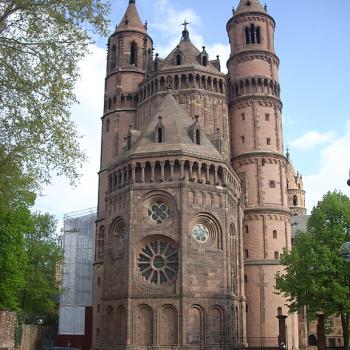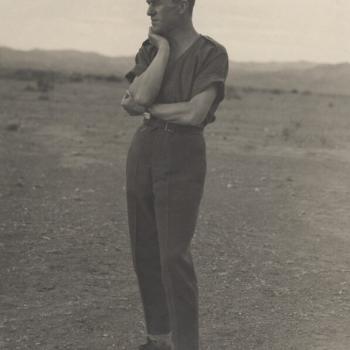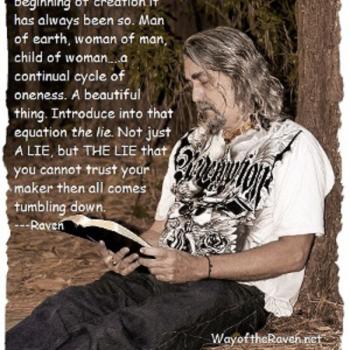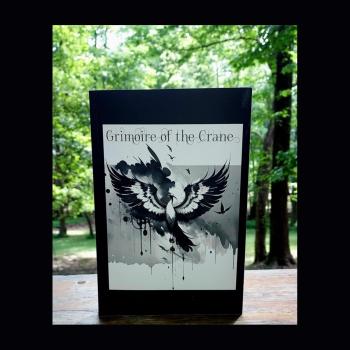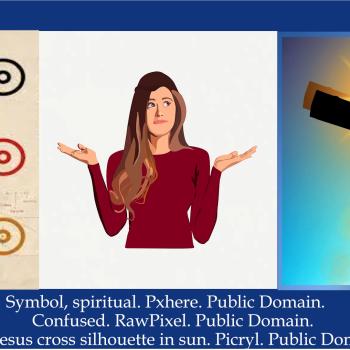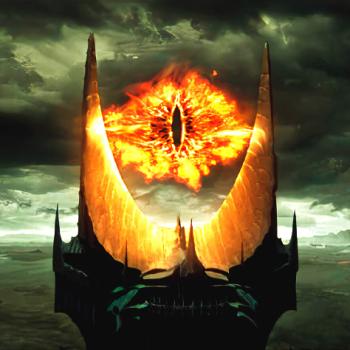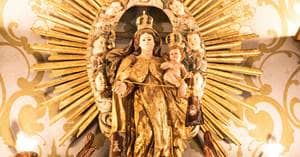
The Virgin Mary, mother of Jesus Christ, is among the most important of the more than ten thousand Roman Catholic Saints. Not only does the Blessed Virgin have many titles by which she is known, but she has also made many apparitions (or visionary appearances) to the faithful as well. One of those important and celebrated appearances was on July 16, 1251—to Simon Stock, an early member of the Roman Catholic Carmelite Order.
Although the story of Mary appearing to St. Simon (in the 13th century AD) is well known among members of the Carmelite order, and by other lay Catholics as well, tradition says that Mary’s first appearance as “Our Lady of Mount Carmel” dates to pre-Christian times. According to the commonly told story, in 860 BC, the prophet “Elijah went up to the top of Carmel; and he cast himself down upon the earth” (1 Kings 18:42). At that time, he began a contemplative life. As an outgrowth of his prayer and contemplation, Catholics (who know the story) believe that Elijah received in vision an awareness of the eventual birth of the Blessed Mother of the Messiah. One tradition claims that the Prophet and those who followed him dedicated their lives to Mary, and looked forward with great anticipation for the day when she would come to save the world through giving birth to the Messiah.
This same tradition asserts that many generations later, the descendants of Elijah and his followers were among “the first to accept the teachings of Christ and to be baptized by His apostles.” These converts to Christ met the Virgin (sometime after Jesus’ ascension) and were immediately awed by her holiness. So greatly moved were they, that they went to Mount Carmel and built a chapel in honor of the “Mother of God.” From the first through the tenth centuries, this sacred mountain is said to have been the home of hermits, pilgrims, monks and mendicants—each seeking to separate themselves from the world and to live the contemplative life (after the pattern of the Virgin Mary).
In the twelfth century, a group of European immigrants (who were followers of the Crusaders) made their way to the Holy Land and, eventually, to Mount Carmel, where they started the Carmelite Order—officially known as the “Brothers of the Blessed Virgin Mary of Mount Carmel.” In the mid-thirteenth century, Simon Stock made his own visit to Jerusalem and there met some men who were part of the Order. Stock joined them, though he and his follow monastics would be forced to leave Mount Carmel by Saracen invaders who took over the holy mountain and its Marian shrine.
Even though the first attested reference to Mary’s appearance to St. Simon Stock is in the late fourteenth century (approximately 150 years after it is said to have happened), the apparition has had significant impact on the Carmelite Order—and even on many outside of the Order. For example, during her appearance, Mary is said to have presented Simon with a brown scapular (Latin for “shoulder”), a sort of cloth neckless and protective amulet that hung both over the back and the chest of the wearer. According to the famed tradition:
“The Scapular of Our Lady of Mount Carmel is the best known, most celebrated, and most widespread of the small scapulars… It is probably the oldest scapular and served as the prototype of the others. According to a pious tradition the Blessed Virgin appeared to St. Simon Stock at Cambridge, England, on Sunday, July 16, 1251. In answer to his appeal for help for his oppressed order, she appeared to him with a scapular in her hand and said: ‘Take, beloved son, this scapular of thy order as a badge of my confraternity and for thee and all Carmelites a special sign of grace; whoever dies in this garment, will not suffer everlasting fire. It is the sign of salvation, a safeguard in dangers, a pledge of peace and of the covenant.’”
The tradition of Our Lady of Mount Carmel’s appearance to Simon Stock developed gradually, over time. Details appear to have been added as the story was told. This is not to say that Catholics believe this to be a fiction; only that the information in the above description is of a late date. Thus, as already noted, the earliest source for this story dates from the late fourteenth century, and the words of Mary (as given above) actually date to 1642 (almost 400 years after the vision). As a result, some have called into question the veracity of the account. Nonetheless, not only did Simon’s vision revitalize the then severely marginalized and oppressed Carmelite Order, but it spawned a tradition of scapular wearing, both among monastics generally, and even among the Roman Catholic laity. Additionally, so famous is this legend that names like María del Carmen (or just Carmen) are very popular among girls in Spanish-speaking nations. Our Lady of Mount Carmel is the patron saint of no less than eighteen countries and causes. Because of Mary’s promise to St. Simon Stock that those who died wearing the scapular would “not suffer everlasting fire,” Our Lady of Mount Carmel has become the patron saint of those needing deliverance from purgatory. Thus, in Catholic iconography, she has ofttimes been depicted in association with the postmortem purgation of sins or surrounded by individuals pleading for her intervention or mediation because of their sins. She is appealed to, celebrated, praised, and depended upon by millions of Roman Catholics worldwide. Her feast day is celebrated on July 16, in honor of the day she appeared in vision to St. Simon Stock.
It is worthy of note that some Catholics believe that Pope John XXII (1244-1334) also had a vision of Our Lady of Mount Carmell. That related tradition goes as follows:
“After Pope John XXII ([who reigned as pope] 1316-1334) had a vision of Mary where she promised those wearing the brown scapular, ‘I, the Mother of Grace, shall descend on the Saturday after their death and whomsoever I find in Purgatory, I shall free, so that I may lead them to the holy mountain of everlasting life’… [As a result,] the scapular became extremely popular among the common people.”
This papal vision led to something called the “Sabbatine Privilege”, or the belief that Our Lady of Mount Carmel would prematurely free from purgatory those who were of the Carmelite Order and those who wore the scapular. Through her grace, and as a “gift,” their release would be an “early release” (i.e., prior to having paid for all their sins), taking place on the Saturday after their death. While the papal bull (Sacratissimo uti culmine), in which John XXII reported his vision and introduced the “Sabbatine Privilege,” is believed to be a fake, nonetheless, it has had significant impact on the Church and the wearing of scapulars down until the late 1970s, when the Catholic Church removed from the liturgy of St. Simon Stock’s feast day any reference to the scapular. While faith in the impact of wearing the scapular has not necessarily diminished among believing Catholics, any sense of “official support” for the practice and the graces associated with it have been withdrawn.
Traditionally, the Roman Catholic Church has categorized various apparitions of the Virgin Mary, delineating which have been “approved” as legitimate and which have received a “negative judgement” by the Church (implying that it is unlikely to be a legitimate apparition). According to the National Catholic Register, as of May 2024, the categories for judging apparitions are as follows:
1) Nihil obstat (Latin, “Nothing obstructs”): Used for phenomena that are connected with “many signs of the action of the Holy Spirit” and so far “no aspects that are particularly critical or risky have been detected.”
2) Prae oculis habeatur (“Let it be held before the eyes”): Used for phenomena that have “important positive signs” but also “some aspects of confusion or potential risks.” Consequently, “doctrinal clarification might be necessary.”
3) Curatur (“It is attended to”): Used for phenomena that have “various or significant critical elements” but have nevertheless “spread widely” and are connected with “verifiable spiritual fruits.” In these cases, the bishop is not to encourage the phenomena and to “seek out alternative expressions of devotion and possibly reorient its spiritual and pastoral aspects.”
4) Sub mandato (“Under mandate”): Used for phenomena that are “rich in positive elements” but that are being misused in some way, such as by “a person, a family, or a group.” Misuse might involve financial gain, immoral acts or defiance of the diocesan bishop.
5) Prohibetur et obstruatur (“Prohibited and obstructed”): Used for phenomena that have “some positive elements” but have very serious “critical issues and risks.” The bishop is to “declare publicly that adherence to this phenomenon is not allowed.”
6) Declaratio de non supernaturalitate (“Declaration of non-supernaturality”): Used for phenomena that the bishop has “found to be not supernatural” based on “facts and evidence that are concrete and proven,” such as a visionary admitting they lied, witnesses detecting fraud or mythomania (an excessive tendency for lying or exaggeration).
While the current system of categorization of apparitions is new, it appears that the appearance of Our Lady of Mount Carmel would fall under the second category—Prae oculis habeatur—suggesting that the Church “officially” believes that there are “important positive signs” that a visitation was received by St. Simon Stock, but that there is some “confusion” around what actually happened on that fateful July 16, of 1251 AD. Thus, some “doctrinal clarification” has been “necessary,” particularly as it relates to the salvific merit of wearing a scapula. Nonetheless, faith-filled Roman Catholics can take solace in the fact that the Church has said that something supernatural happened in 1251, and in some form or other, Our Lady of Mount Carmel continues to watch over millions of Catholics, mediating, blessing, and pouring out her grace upon them.
8/6/2024 5:56:15 PM

